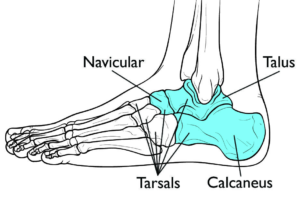Dear Students:
The weight bearing bone of the ankle is called the talus bone and it sits on top of the heel which is the calcaneus bone. Ideal walking requires you to move your  head, vertebral column, pelvis & leg bones directly over the talus bone for optimal balance. The ankles are designed to aid in this alignment process from the bottom up through swiveling motions of the lower leg bones, the tibia & fibula & feet. When you instinctively pivot your feet around this is a sign that your neurological system is stimulating your entire muscular & skeletal systems to find a balancing point.
head, vertebral column, pelvis & leg bones directly over the talus bone for optimal balance. The ankles are designed to aid in this alignment process from the bottom up through swiveling motions of the lower leg bones, the tibia & fibula & feet. When you instinctively pivot your feet around this is a sign that your neurological system is stimulating your entire muscular & skeletal systems to find a balancing point.
I have included a video for you to watch of a gymnast’s feet moving on a balance beam so you can see how her ankles help her quickly find center. Because she is very skilled at balancing you must look closely to see her feet in motion when she is merely walking. Stay tuned in to see her land a bit off balance when she does a “cat jump” or when she stands on one leg, so you won’t miss what her feet have to do to keep her on the beam.
You can invoke these innate lower leg movements within yourself simply by removing your shoes &/or strolling on surfaces such as sand or dirt and/or exploring the mini-lesson that I share with you today. This short walking exploration can help you experience your amazing ankles! Have fun with it & remember the more you explore in a gentle & non-judgmental way the better you can become at it.
Lesson: Walking on a Line [During this lesson move with gentleness & awareness. If you experience any discomfort during the exploration, stop immediately & rest. Rest as soon as you become tired. Imagine doing the movements if you can not do it without pain or discomfort.] 1. Walk slowly on an imaginary line on the floor taking each step with your heels touching your toes. This means each time, place your frontfoot on the line so you feel your heel lightly touching the big toe & 2nd toe of your back foot. Walk with your arms straight out to the sides. Rest when you become tired or are no longer interested in the process. 2. This time walk on the line 50% slower. Notice when you speed up. Does this happen while standing on one leg more than on the other? Which foot swivels more easily? Rest in sitting. 3. Walk backwards in the same manner. Go 50% slower each time you do it. Notice if you stop breathing or inhibit your breathing. Rest. 4. If you want, challenge yourself by placing your arms down by your sides or cross your arms over your chest & rest your elbows on your torso. Walk in this way once forwards & then backwards -75% slower each time. Is this more difficult? Where do you effort unnecessarily? Rest.
I hope this lesson helps to prepare your legs for enhanced movement during all your recreational activities this summer. Peace to all on Earth!
~Donna
Contact Donna Bervinchak at: